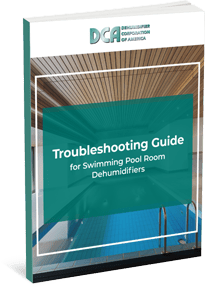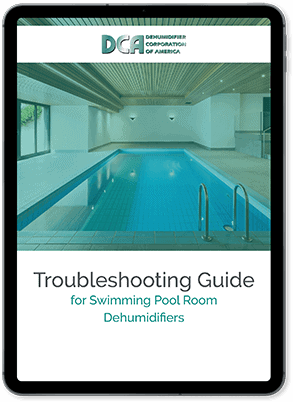The type of dehumidification system you select will dictate how well it performs within your industrial space. For example, selecting a system that is too small will not remove the proper amount of moisture from the facility. Having the proper commercial dehumidifier is necessary to protect a wide variety of facilities from corrosion to equipment, mold and mildew buildup, or damage to raw materials.
Through the use of industrial dehumidifiers, facility managers and owners will be able to effectively control humidity levels, room temperatures, and dew points. As you search for a dehumidifier for your facility, it’s important to find one that’s the right size based on your application’s unique requirements.
Evaluating Dew Point In Your Facility
If a desired dew point is critical, many factors must be considered. In general, mechanical, refrigerated dehumidifiers are best suited for maintaining dew points above 50°F and ambient room temperatures above 60°F. If your facility calls for a dew point lower than 50°F, or the ambient room temperature is below 60°F, desiccant style dehumidifiers are normally used. Sometimes they are also used in tandem with mechanical dehumidifiers.
If a specific dew point is not critical, maintaining the room’s relative humidity at 50% will go a long way in controlling mold, mildew, corrosion, rusting and other unwanted moisture problems. When a specific room dew point is mandatory, accurate dew points must be determined.
Determining Moisture Load and Source In Your Facility
Determining the moisture load and the source is critical when selecting the proper dehumidification system. The following are common moisture load sources that need to be considered:
- Geographical location of the room or building and typical winter and summer weather data
- Is the controlled room inside a building or a stand-alone building?
- If the room is inside a building, is the area around that room in a heated & cooled environment?
- Is the building or room construction considered tight, average or loose?
- Type of building materials used: wood frame, masonry, metal or other
- Whether a vapor barrier is in place on the ceiling and exterior walls
- Type of vapor barrier present, if any
- Are the walls and ceiling insulated using an integral vapor barrier?
- Number of man doors and windows in the space and relative tightness
- Number and size of overhead doors present and relative tightness
- Number of minutes outside man and overhead doors are open to the outdoors per hour
- Is the room or building presently heated & cooled? If yes, how many tons of cooling are present?
- Number of people normally working in the space
- Are there any exhaust fans in the building presently? If yes, how many total CFM’s?
- Are there any gravity make-up air ducts in the space and size of the ducts or roof vents
- Are there any operations or procedures in the room that contribute to the moisture load?
- Any standing or weeping water on the floors or the walls
- Is product in the room or building drying and contributing moisture into the space?
- Determining the room or building volume (length-width-height) to be controlled
If there are large amounts of outdoor air already being introduced into the controlled space, and especially if that air is drawn from a humid climate, dedicated outdoor air dehumidifiers are a good choice to remove this excess moisture before it enters the controlled space.
Industrial Dehumidifiers from DCA
The industrial dehumidifiers available at DCA come with a wide variety of customizable design features to make them suitable for many applications and environments. For example, we can provide:
Horizontal or Vertical Configurations
Vertical dehumidifiers are typically installed on the floor and have a smaller footprint. Meanwhile, horizontal dehumidifiers are normally floor-mounted or suspended from ceilings, with more discharge options available.
Indoor or Outdoor Installations
DCA’s horizontal dehumidifiers are installable either indoors or outdoors in locations such as ground installations or rooftops.
Water-cooled Models
Water-cooled dehumidifiers are often installed in locations in proximity to a water source, enabling them to funnel condenser heat into municipal or processed water, loops, cooling towers, heat pumps, or other water sources. These models don’t require an air cooled outdoor remote condenser, allowing the system to provide spaces with sufficient levels of cool or warm dry air.
Dedicated or BMS Control Compatibility
Our selection of industrial dehumidifiers uses a variety of dedicated cutting-edge building management systems (BMS) as control points.
Heating Systems
Choose from external electric, external gas, or internal hot water heating coils, which will allow you to deliver heating and cooling to spaces in a single package.
Other
Facility managers can make use of various add-ons to optimize the dehumidifier capabilities. These add-ons could include odor removal systems, dust control filters, and heating and cooling controls for water and air.
Working with Dehumidifier Corporation of America
The experts at Dehumidifier Corporation of America are proud to supply our customers with top-quality industrial dehumidifiers for use in nearly any application. Depending on your individual requirements, we can provide you with the right solution that yields the best results for moisture, temperature, and dew point control. Our equipment is available in water- or air-cooled variations that use sources such as cooling towers, city and processed water, geothermal energy, and chillers. If you need a dependable industrial dehumidifier for your application, we can help you find exactly what you’re looking
To learn more about our selection of industrial dehumidifiers, contact us today. You can also request a quote for our products to get started on an installation for your facility.
Topics: Dehumidifiers, Industrial dehumidifiers





